 Marine Nationale (1888), Protected cruiser, 1889-1919
Marine Nationale (1888), Protected cruiser, 1889-1919WW1 French Cruisers
Sfax | Tage | Amiral Cecille | D'Iberville class | Dunois class | Foudre | Davout | Suchet | Forbin class | Troude class | Alger class | Friant class | Linois class | Descartes class | D'Assas class | D’Entrecasteaux | Protet class | Guichen | Chateaurenault | Chateaurenault | D'Estrées class | Jurien de la Graviere | Lamotte-Picquet classDupuy de Lome | Amiral Charner class | Pothuau | Jeanne d'Arc | Gueydon class | Dupleix class | Gloire class | Gambetta class | Jules Michelet | Ernest Renan | Edgar Quinet class
Amiral Cécille was the third protected cruiser built in France, with a blend of inspirations and features coming from Sfax and Tage. Like her shehad a dual role, commerce raider to attack merchant shipping in wartime, and colonial or station cruiser in peacetime. Since long range was required, she carried a barque sailing rig. Amiral Cécille had about the same main battery as her predecessors, with eight 164 mm (6.5 in), and a lightly better curved armor deck. She had a largely uneventful career, at first in the Mediterranean Squadron, overhauled in the mid-1890s, transferred to the Reserve Squadron, detached for the Atlantic Division in 1899 for three years and back in the Med by 1902, seeing limited service until hulked in 1907, BU in 1919.
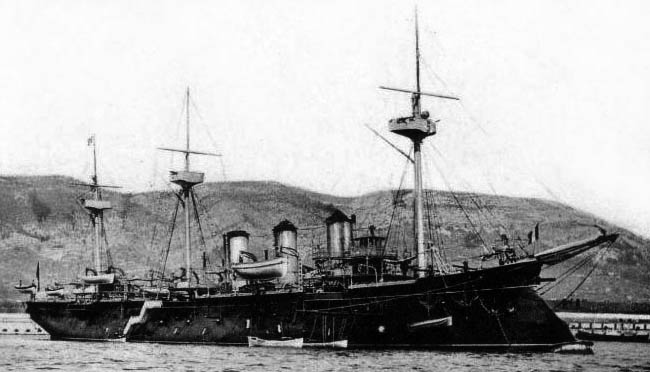
Amiral Cecille after 1895
Design of the class
Design Development
In 1878, seven years after the disastrous Franco-Prusian war in a budget-stripped context, the French Navy wanted a serie of cruiser, studied and authorized by the Conseil des Travaux (Council of Works) which could attacking British merchant shipping in case of war. The new strategy was no longer to seek a peer-to-peer battlefleet decision, but seeking asymetric warfare at sea, befiore heading towards a more technologic approach through the Jeune Ecole. This program called for 3,000 long tons (3,048 t) cruisers capable of 16 knots (30 km/h; 18 mph) and a long range, which implied fully rigged. The first four were wood-hulled and unprotected but the fifth vessel (Capitaine Lucas) was cancelled in favor Louis-Émile Bertin’s protected cruiser design, Sfax, the basis similar follow-on ships: Tage (by Charles Jaÿ) and Amiral Cécille (by Antoine Lagane), ordered in 1885.

The design of Amiral Cecille was prepared by naval engineer Antoine Lagane, director of the Société Nouvelle des Forges et Chantiers de la Méditerranée (FCM) shipyard, La Seyne-sur-Mer, Mediterranean. Lagane submitted this design (hoping a contract) to the Minister of the Navy, which at the time was Rear Admiral Charles-Eugène Galiber, on 8 April 1885. The design met the new requirements from Conseil des Travaux of 1884. Instead of 16 knots, the top speed was now raised to 19 knots (35 km/h; 22 mph). She had the same armament as Sfax, six 164.7 mm (6.48 in) guns and ten 138.6 mm (5.46 in) guns as planned. Galiber submitted Lagane’s proposal to the Conseil on 17 June. It was evaluated on a meeting on 7 July, end concluded favroably but with the reserve of minor revisions, notably with the thickness of the deck armor that was judged unsufficient. This final design was approved after a counter-design proposal was accepted, and an order placed to FCM La Seyne with the contract signed on 23 November. Amiral Cecille was named after Admiral Jean-Baptiste Cécille (1787-1873) which recently died. He was an Admiral and politician playing an important role in the French intervention of Vietnam and also circumnavigated the globe.
Hull and general design
Amiral Cecille measured 115.5 m (378 ft 11 in) between perpendiculars, 117.6 m (386 ft) at the waterline, 122.4 m (401 ft 7 in) overall between her clipper poop/overhanging stern above water and pronounced ram bow tip underwater. This was for a beam of 15.03 m (49 ft 4 in), average draft of 6.03 m (19 ft 9 in), down to 6.81 m (22.3 ft) aft. This was very comparable to Tage (118.87 x 16.3 x 7.67 m or 390 x 53 ft 6 in x 25 ft 2 in) albeit she was nimbler to achieve greater speeds, with one meter less in beam, three meters more in lenght and a meter less in draught. To compensate any stability issues she received even more tumblehome, meaning a pear-like section, with a generous beam, and reduced deck.
She displaced 5,790.3 t (5,698.9 long tons; 6,382.7 short tons) as designed but 6,137 t (6,040 long tons; 6,765 short tons) at full load (measured in 1900) which wazs less than Tage (7,469 long tons (7,589 t)). Her superstructure was kept minimal, as on previous cruisers with of a small conning tower forward of the funnels, and enclosed, then open deck above. The hull featured as usual a pronounced ram bow with a short forecastle. Unlike Sfax, this now was not reinforced, only usable against light vessels. The crew comprised 486 officers and enlisted men, and up to 557 when acting as flasghip, housing in addition the admiral’s staff.
Powerplant
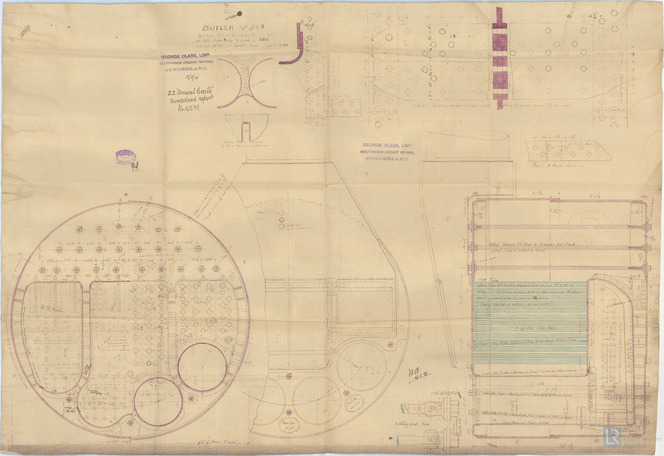
Her propulsion system was similar t previous ships, featuring here four vertical 2-cylinder compound steam engines, paired, driving two 4-bladed, bronze screw propellers. Steam came from twelve coal-fired and double-ended fire-tube boilers all produced locally, ducted into three funnels amidships so she looked alike Tage. To supplement this steam propulsion overseas she also had her original barque sailing rig, without royals, on three masts.
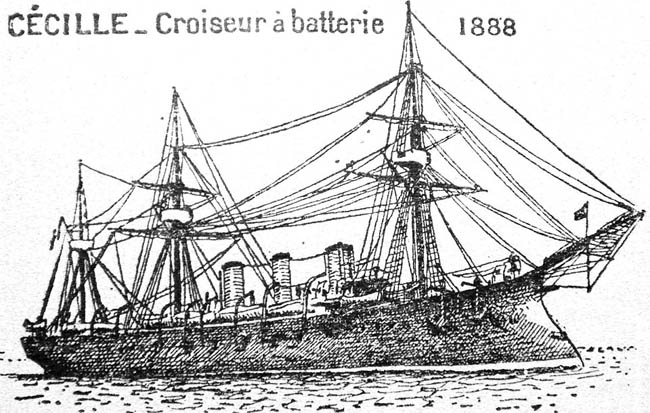
The power plant had an output combined of 10,200 indicated horsepower (7,600 kW) making for the required top speed of 19 knots (35 km/h; 22 mph). She did a bit better in her initial speed trials, reaching 19.44 knots (36.00 km/h; 22.37 mph) based on 10,680 ihp (7,960 kW). This was less than Tage which opted for more modern, very large VTE engine capable of 12,500 ihp (9,300 kW) instead. She was however a bit slower at 19.2 knots (35.6 km/h; 22.1 mph). Lagane’s calculation of weight conducted to the conclusion the ships would be better balanced with two pairs of smaller engines rather than two very large ones.
Coal storage was 717 t (706 long tons; 790 short tons) at normal load, 850 t (840 long tons; 940 short tons) fully loaded for a cruising radius of 2,868 nautical miles (5,312 km; 3,300 mi) at the economical speed of 10 knots (19 km/h; 12 mph) based on her normal, peacetime load of coal. But ot could be raised to 3,400 nmi (6,300 km; 3,900 mi) with a full load. Unfortunately for Lagane, his choice of powerplant and especially boilers was not a happy one. Cecille indeed happened to be a bad steamer, burning much more coal than expected, and never exceededing 2,850 nmi (5,280 km; 3,280 mi) on a normal load while in service. To compared, Tage was capable of a much larger range of 4,642 nm (8,597 km; 5,342 mi) at 12 knots. This limited Cecille’s combined operations with the Atlantic fleet as well.
Protection
Amiral Cecille was protected by wrought iron armor. Her curved (turtledeck) was 40 mm (1.6 in) on its flat portion and ran from end to end, layered on 10 mm (0.39 in) of hull plating. This deck sloped down on either side, increasing in thickness to 90 mm (4 in) on top, above the waterline, and then tapering to 85 mm (3.3 in) as it met the structural hull sides. These were layered this time on 15 mm (0.59 in) hull plating and went down to 1.30 m (4 ft 3 in) below the waterline.
The battery was also enclosed by transverse bulkheads 80 mm (3.1 in) on either end. Lagane reduced the bow and stern thickness to save weight in what he estimated less critical areas, despite the Conseil requested a uniform thickness.
The conning tower forward had walls also 80 mm (3.1 in) thick.
Lagane appeared to be creative with the ASW protection, and if there was the same cofferdam above the protective deck as professed by Bertin, she appears to have had better underwater compartmentation than Tage. There is no info on her use of a floatable material inside these protective compartments.
Armament
Amiral Cecille was design to carry the same armament as Sfax initially, so six 164.7 mm (6.48 in) M1881 28-cal. guns in individual pivot mounts, and a secondary battery of ten 138.6 mm (5.46 in) M1881 30 cal. guns in the main deck battery amidships, all on individual mounts, plus a close in defence made of 18 light Hotchkiss guns of 47 and 37 mm, rounded up by seven 356 mm (14 in) torpedo tubes above the waterline. However on 6 July 1889, while under sea trials, the navy decided to add two more 164.7 mm guns installed later that year, before she was accepted for active service.
Main battery:
Cecille had eight 164.7 mm (6.48 in) M1881 28-caliber were placed on single pivot mounts. One gun was located in the bow under the forecastle, the other at the stern on the upper deck as chase gun, and the remainder in casemates along the sides. There is no data on these models. Navweaps database starts with the M1891.
Secondary battery:
It comprised ten 138.6 mm (5.46 in) M1881 30 cal. guns carried in a main deck battery amidships, and five guns per broadside with individual gun ports. Same comment as above, no data on these, navweaps starts with the M1884 src. It was capable of 16,400 yards (15,000 m) max range at 25°. It fired either an AP 80.5 lbs. (36.5 kg) ot HE 69.4 lbs. (31.5 kg) shells at 2,379 fps (725 mps) and 2,510 fps (765 mps) respectively. The M1881 was probably below these figures.
Light battery:
She carried:
-Six 47 mm (1.9 in) M1885 3-pounder Hotchkiss guns in individual mounts, partly in hull casemates, remainder on the battery deck.
-Fourteen 37 mm (1.5 in) 1-pounder Hotchkiss revolver cannon in individual mounts. Mostly high up in the bdirged, later relocvated to the fighting tops when refitted.
Torpedo Tubes:
Like previous cruisers she carried four 356 mm (14 in) torpedo tubes in her hull, all above the waterline, one in the bow, one on each broadside, and one in the stern in the typical lozenge pattern of the day. There are conflicting infos on the date, but she had her stern tube removed in the 1900s. She received three more for a short time as TB TS (see later).
Modernization
In 1893, Amiral Cécille saw the complete renweal of her primary and secondary guns, later models but on the same calibers for easier istallation, and now quick-firing:
The 30-caliber M1881 164.7mm were replaved by M1884, as were the 138.6 mm. The light arrtillery was also updated to the 47mm/40 M1885, and 37mm/20 M1885. No change for the torpedo tubes.
The sailing rig was however cut down two years later, in 1895, then removed altogether for military masts with fighting tops wheeras the bow torpedo tube was removed in 1898.
1900s: Two 65 mm (2.6 in) field guns were embarjed to be used ashore with a landing party.
The light armament now comprised twelve 47 mm M1885 guns, all 37 mm removed.
From 1907 she became a training ship for torpedo boat crews and saw the addition of three deck-mounted torpedo tubes close to the bow, starboard showcasing all models in service at the time, the old 356 mm, a 381 mm (15 in), and a 450 mm (17.7 in). No apparent change in artillery. She was hulked afterwards in this state.
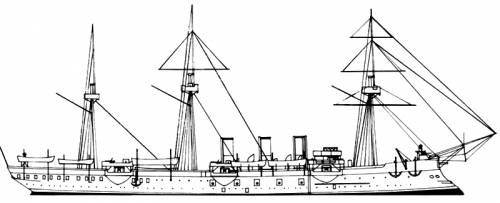
⚙ Amiral Cecille specifications |
|
| Displacement | 5,790.3 t (5,698.9 long tons; 6,382.7 short tons) |
| Dimensions | 122.4 x 15.03 x 6.03m (401 ft 7 in x 49 ft 4 in x 19 ft 9 in) |
| Propulsion | 2 shafts, 4 × compound steam engines, 12 × fire-tube boilers, 10,200 ihp (7,600 kW) |
| Speed | 19 knots (35 km/h; 22 mph) |
| Range | 2,850 nmi (5,280 km; 3,280 mi) at 10 knots (19 km/h; 12 mph) |
| Armament | 8 × 164.7 mm, 10 × 138.6 mm, 6 × 47 mm (1.9 in), 14 × 37 mm (1.5 in), 4 × 356 mm TT |
| Protection | Deck 56 to 102 mm (2.2 to 4 in), CT 89 mm (3.5 in) |
| Crew | 486 |
Career of Amiral Cecille
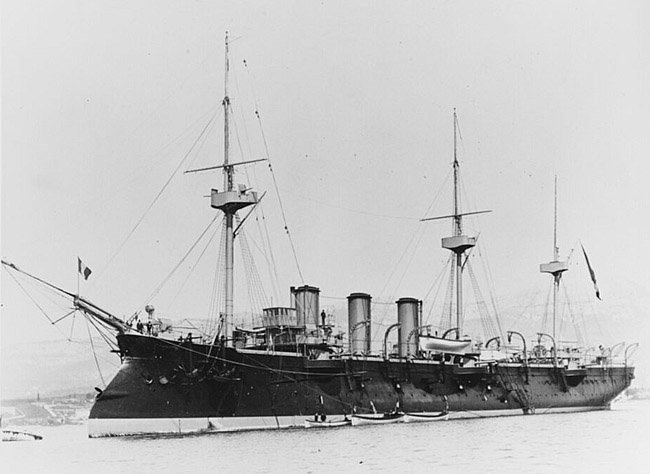
Amiral Cécille was laid down at the S.N.F.C.M shipyard, La Seyne-sur-Mer, on 1 September 1886. Her completed hull was launched on 3 May 1888. She was commissioned for her sea trials on 26 January 1889, then approved on 9 October 1890 for full commission. She took part in the 1891 fleet maneuvers with the Mediterranean Squadron, cruiser division with Tage, Lalande, and the torpedo cruiser Vautour from 22 June to 11 July, as part of a hostile fleet marauding the Mediterranean coast. The shortage of cruisers fast enough for scouting for the main fleet was reduced to Amiral Cécille and Tage as evaluated in these exercises.
By 1893, Amiral Cécille joined the reconnaissance force alongside the new armored cruiser Dupuy de Lôme and protected cruiser Jean Bart.
On 25 July, she accidentally rammed a British freighter when the latter passed in front of her too closely, sinking as a result. Amiral Cécille needed repairs to her bow between September 1893 and July 1894 at La Seyne-sur-Mer. At this occasion her armament was updated as well and her boilers overhauled. Work was completed in 1895 and she took part of that year’s maneuvers in “Fleet C” comprising four ironclads, three cruisers, several torpedo boats from 1 to 27 July. Mid-way on the 15th, Amiral Cécille her propulsion completely broke down she had to leave and return to Toulon for repairs. By 1896, Amiral Cécille was reassigned to the Reserve Squadron in her cruiser division with Sfax, Lalande, and Milan. Maneuvers went from 6 to 30 July 1896 and she was part again of the “red force”.
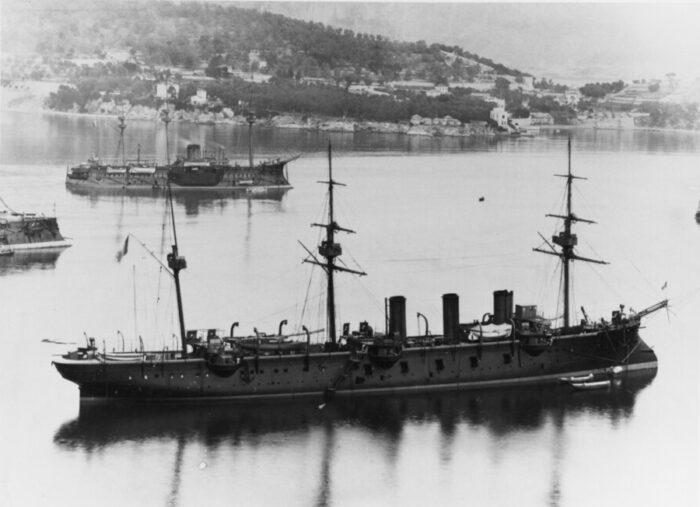
In 1899, Amiral Cécille relieved the old cruiser Dubourdieu at the Atlantic Naval Division, joining Sfax. By late January 1900 she left Fort-de-France in Martinique (French East Indies) for the west coast of Africa with the protected cruisers Suchet, D’Assas, and Troude, but less Sfax. This flotilla was later reduced to Amiral Cécille, Suchet, D’Estrées in 1901. She was recalled to the Mediterranean by 1902 to have her boilers overhauled and was practically mothballed afterwards. She was assigned to the Special Reserve on 9 January 1903, decommissioned on 24 September 1906, struck on 27 August 1907. Instead of being bsold for BU she was converted into a hulk in 1908, acting as torpedo boat engine room crews support ship, replacing Algésiras, accidentally been destroyed by fire.
In 1910, she was reassigned to the torpedo school at Toulon, replacing Marceau, until 1912. Presumably she had been disarmed in 1907. She was then converted and used as a barracks ship, hulked at Toulon ub 1917, replacing the old frigate Guerrière. She was ultimately sold for scrap on 15 March 1919, to M. Saglia on 21 July.



From Pinterest
Read More/Src
Books
Brassey, Thomas A. (1893). “Chapter IV: Relative Strength”. The Naval Annual. Portsmouth: J. Griffin & Co
Brassey, Thomas A. (1899). “Chapter III: Comparative Strength”. The Naval Annual. Portsmouth: J. Griffin & Co.
Brassey, Thomas A. (1902). “The Fleet on Foreign Stations”. The Naval Annual. Portsmouth: J. Griffin & Co.
Thursfield, J. R. (1892). Brassey, Thomas A. (ed.). “Foreign Naval Manoeuvres”. The Naval Annual. Portsmouth: J. Griffin & Co.
Thursfield, J. R. (1897). Brassey, Thomas A. (ed.). “Naval Manoeuvres in 1896”. The Naval Annual. Portsmouth: J. Griffin & Co.
Weyl, E. (1896). Brassey, Thomas A. (ed.). “Chapter IV: The French Navy”. The Naval Annual. Portsmouth: J. Griffin & Co.
Campbell, N. J. M. (1979). “France”. In Gardiner, Robert (ed.). Conway’s All the World’s Fighting Ships 1860–1905.
Clowes, W. Laird (1894). Brassey, Thomas A. (ed.). “Toulon and the French Fleet in the Mediterranean”. The Naval Annual. Portsmouth: J. Griffin & Co.
Fisher, Edward C., ed. (1969). “157/67 French Protected Cruiser Cecille”. Warship International. VI (3). Toledo: International Naval Research Organization.
Gleig, Charles (1896). Brassey, Thomas A. (ed.). “Chapter XII: French Naval Manoeuvres”. The Naval Annual. Portsmouth: J. Griffin & Co.
Jordan, John & Caresse, Philippe (2017). French Battleships of World War One. NIP
Leyland, John (1900). Brassey, Thomas A. (ed.). “Chapter III: Comparative Strength”. The Naval Annual. Portsmouth: J. Griffin & Co.
Maw, W. H.; Dredge, J., eds. (24 July 1891). “The French Navy–No. XII. The “Cecille””. Engineering: An Illustrated Weekly Journal. London: Offices for Advertisements and Publication.
Roberts, Stephen (2021). French Warships in the Age of Steam 1859–1914. Barnsley: Seaforth.
Ropp, Theodore (1987). Roberts, Stephen S. (ed.). The Development of a Modern Navy: French Naval Policy, 1871–1904. NIP
“Ships: France”. Journal of the American Society of Naval Engineers. III.
Links
web.archive.org navypedia.org/ amiral_cecille
en.wikipedia.org French_cruiser_Amiral_Cecille
commons.wikimedia.org/
Model Kits
None, want one ?

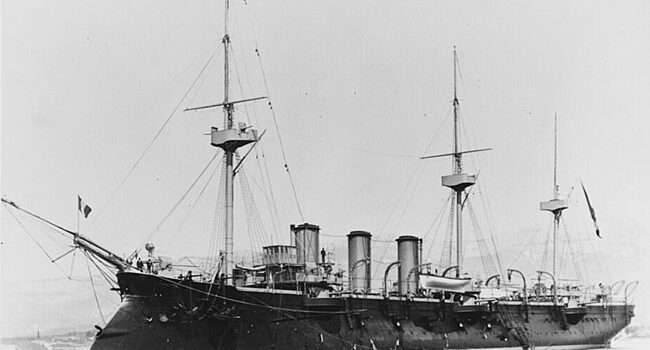
 Latest Facebook Entry -
Latest Facebook Entry -  X(Tweeter) Naval Encyclopedia's deck archive
X(Tweeter) Naval Encyclopedia's deck archive Instagram (@navalencyc)
Instagram (@navalencyc)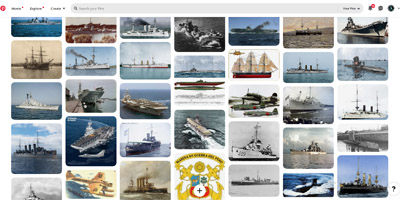


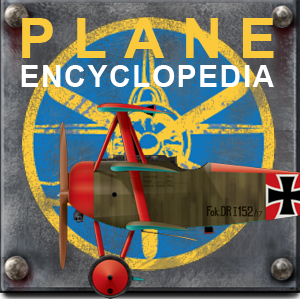
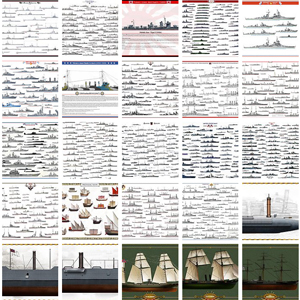
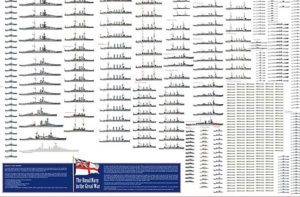
 French Navy
French Navy Royal Navy
Royal Navy Russian Navy
Russian Navy Armada Espanola
Armada Espanola Austrian Navy
Austrian Navy K.u.K. Kriegsmarine
K.u.K. Kriegsmarine Dansk Marine
Dansk Marine Nautiko Hellenon
Nautiko Hellenon Koninklije Marine 1870
Koninklije Marine 1870 Marinha do Brasil
Marinha do Brasil Osmanlı Donanması
Osmanlı Donanması Marina Do Peru
Marina Do Peru Marinha do Portugal
Marinha do Portugal Regia Marina 1870
Regia Marina 1870 Nihhon Kaigun 1870
Nihhon Kaigun 1870 Preußische Marine 1870
Preußische Marine 1870 Russkiy Flot 1870
Russkiy Flot 1870 Svenska marinen
Svenska marinen Søværnet
Søværnet Union Navy
Union Navy Confederate Navy
Confederate Navy Armada de Argentina
Armada de Argentina Imperial Chinese Navy
Imperial Chinese Navy Marinha do Portugal
Marinha do Portugal Mexico
Mexico Kaiserliche Marine
Kaiserliche Marine 1898 US Navy
1898 US Navy Sovietskiy Flot
Sovietskiy Flot Royal Canadian Navy
Royal Canadian Navy Royal Australian Navy
Royal Australian Navy RNZN Fleet
RNZN Fleet Chinese Navy 1937
Chinese Navy 1937 Kriegsmarine
Kriegsmarine Chilean Navy
Chilean Navy Danish Navy
Danish Navy Finnish Navy
Finnish Navy Hellenic Navy
Hellenic Navy Polish Navy
Polish Navy Romanian Navy
Romanian Navy Turkish Navy
Turkish Navy Royal Yugoslav Navy
Royal Yugoslav Navy Royal Thai Navy
Royal Thai Navy Minor Navies
Minor Navies Albania
Albania Austria
Austria Belgium
Belgium Columbia
Columbia Costa Rica
Costa Rica Cuba
Cuba Czechoslovakia
Czechoslovakia Dominican Republic
Dominican Republic Haiti
Haiti Hungary
Hungary Honduras
Honduras Estonia
Estonia Iceland
Iceland Eire
Eire Equador
Equador Iran
Iran Iraq
Iraq Latvia
Latvia Liberia
Liberia Lithuania
Lithuania Mandchukuo
Mandchukuo Morocco
Morocco Nicaragua
Nicaragua Persia
Persia San Salvador
San Salvador Sarawak
Sarawak Uruguay
Uruguay Venezuela
Venezuela Zanzibar
Zanzibar Warsaw Pact Navies
Warsaw Pact Navies Bulgaria
Bulgaria Hungary
Hungary

 Bundesmarine
Bundesmarine Dutch Navy
Dutch Navy Hellenic Navy
Hellenic Navy Marina Militare
Marina Militare Yugoslav Navy
Yugoslav Navy Chinese Navy
Chinese Navy Indian Navy
Indian Navy Indonesian Navy
Indonesian Navy JMSDF
JMSDF North Korean Navy
North Korean Navy Pakistani Navy
Pakistani Navy Philippines Navy
Philippines Navy ROKN
ROKN Rep. of Singapore Navy
Rep. of Singapore Navy Taiwanese Navy
Taiwanese Navy IDF Navy
IDF Navy Saudi Navy
Saudi Navy Royal New Zealand Navy
Royal New Zealand Navy Egyptian Navy
Egyptian Navy South African Navy
South African Navy






























 Ukrainian Navy
Ukrainian Navy dbodesign
dbodesign